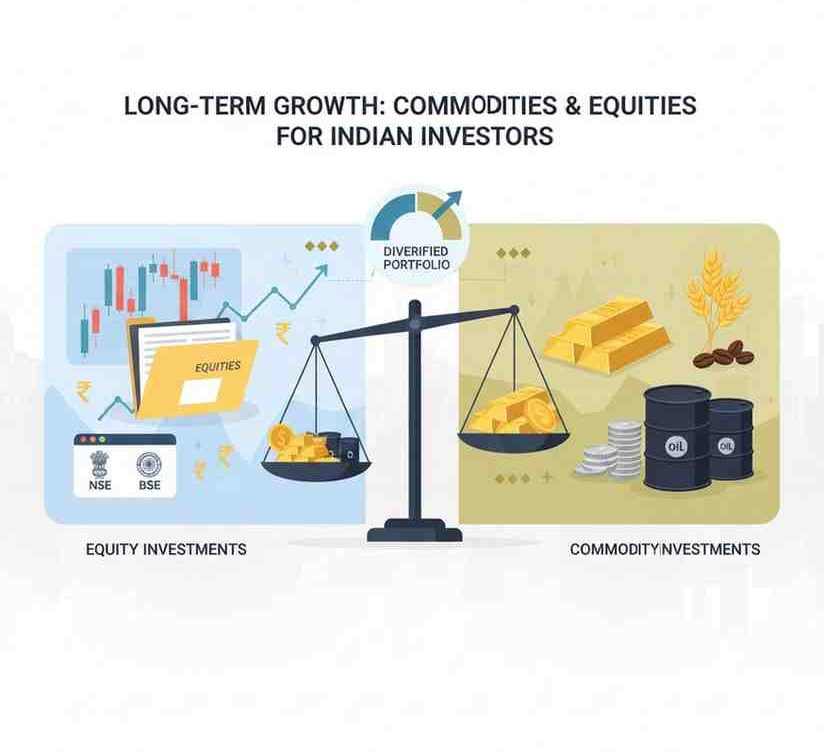
Long-Term Growth: How Commodities Complement Equity Investments
Long-Term Growth: How Commodities Complement Equity Investments
Investing in financial markets requires a nuanced understanding of risk, returns, and long-term growth potential. While equities often dominate discussions around wealth creation, commodities play a significant yet sometimes understated role in enhancing portfolio stability and diversification. For Indian investors seeking sustainable growth, combining commodities with equity investments can offer strategic advantages.
How Commodities Complement Equity Investments in a Diversified Portfolio
Equities are typically sensitive to corporate performance and macroeconomic cycles, whereas commodities respond more directly to global demand, supply dynamics, and geopolitical events. Including assets such as gold, silver, and oil in an investment portfolio can provide a counterbalance to equity volatility.
For example, during periods of equity market downturns, commodities like gold often retain value or even appreciate, acting as a natural hedge. Similarly, oil and agricultural commodities can offer exposure to global market trends that are largely independent of Indian stock market movements. This complementary behavior underscores the importance of commodities in long-term portfolio strategies.
Role of Commodities in Building Long-Term Growth and Stability
The role of commodities in long-term portfolio growth extends beyond mere risk mitigation. Commodities provide a means to manage inflationary pressures, which can erode the real returns from equity investments. In India, where inflation has historically been a significant concern, exposure to commodities like gold and silver can protect purchasing power over time.
Moreover, commodities can enhance risk-adjusted returns. By blending equity and commodity investments, investors can reduce the overall portfolio volatility without sacrificing potential returns. Asset allocation strategies that incorporate both equities and commodities are particularly effective for long-term investors focused on wealth creation while maintaining a balanced risk profile.
Balancing Risk and Returns with Commodities and Equities
Effective investment requires balancing risk and returns. Equities may offer higher growth potential, but they also come with significant short-term volatility. Commodities, by contrast, can provide stability and act as a hedge during market corrections.
Investors can manage volatility by strategically allocating capital between equities and commodities based on market conditions. Commodity index funds and ETFs are practical tools for gaining diversified exposure to multiple commodities without the complexities of direct trading. By combining these instruments with a well-curated equity portfolio, investors can achieve a more resilient investment strategy.
Why Investors Use Commodities as a Hedge Against Equity Volatility
In addition to long-term growth, commodities serve as a safeguard against unexpected market shifts. For instance, during economic slowdowns or geopolitical tensions, stock markets may experience sharp declines. Commodities, particularly precious metals, often move inversely to equities in such scenarios.
This characteristic makes commodities an essential component of portfolio diversification through commodities and equities. Indian investors can use commodity exposure to offset short-term equity losses, ensuring that their portfolios remain aligned with long-term financial goals.
Diversification Strategies: Combining Commodities and Equities for Sustainable Returns
Diversification is a core principle of modern portfolio management. By combining commodities and equities, investors can reduce the impact of cyclical market performance on their portfolios. Equities may perform strongly during economic expansions, while commodities can provide stability during downturns or periods of rising inflation.
A balanced allocation strategy may include a mix of gold, silver, oil, and select agricultural commodities alongside a diversified set of Indian and global equities. Long-term investors can also consider commodity-focused mutual funds or ETFs to achieve exposure while simplifying portfolio management. This approach allows for sustainable long-term growth and helps manage risk-adjusted returns effectively.
Key Considerations for Indian Investors
When integrating commodities into an equity-focused portfolio, several factors should guide decision-making:
- Correlation Analysis: Understanding how commodity prices move in relation to equities can help optimize asset allocation.
- Inflation Protection: Precious metals and select commodities act as hedges against rising costs, preserving real returns.
- Market Cycles: Recognizing the cyclical nature of commodities and equities helps in timing investments strategically.
- Investment Instruments: Commodity index funds, ETFs, and direct commodity contracts provide flexibility for different risk appetites.
By thoughtfully combining commodities and equities, Indian investors can build portfolios that not only target growth but also withstand market uncertainties. This approach aligns with long-term wealth creation objectives while offering diversification benefits and a hedge against market volatility.
Conclusion
Commodities and equity investment strategies are not mutually exclusive. When used in tandem, they complement each other to deliver balanced risk-adjusted returns and long-term portfolio growth. By integrating commodities into equity-focused portfolios, investors gain exposure to inflation-hedging assets, achieve diversification, and enhance the stability of their investments. For Indian investors navigating complex market dynamics, a thoughtful mix of commodities and equities can provide a sustainable path to financial growth.
Download the app today to start your trading journey on your Android device: (Download GigaPro Mobile App) or on your Apple device: (Download GigaPro Mobile App).
Related Blogs:
How Commodity Exposure Enhances Portfolio Resilience with Equities
What is Sector Rotation and How Does it Work?
How to Implement Diversification for a Profitable Portfolio
Build a Stronger Investment Portfolio Through Diversification
Diversification Strategies: Combining Commodities and Equities
Diversification Strategies: Why Spreading Your Risk Matters
How to Use Sector Rotation to Diversify Your Portfolio
Why Diversification Strategies Matter for Managing Investment Risk
Why Trade Commodities? Harnessing Diversification and Inflation Hedge Potential
How Do Asset Allocation and Diversification Work Together?
How to Diversify Your Portfolio with Commodities: A Strategic Approach
Building an All-Weather Portfolio for the Indian Investor Integrating Equities, Bonds, and Commodities
The Rising Appeal of Commodities for Indian Investors
Commodity Trading: Key Strategies for Risk Management and Informed Decisions
Disclaimer: This blog post is intended for informational purposes only and should not be considered financial advice. The financial data presented is subject to change over time, and the securities mentioned are examples only and do not constitute investment recommendations. Always conduct thorough research and consult with a qualified financial advisor before making any investment decisions.
